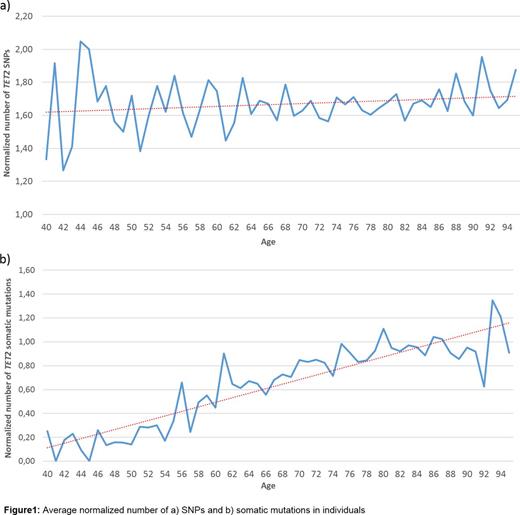Abstract
Introduction: Mutations in the ten-eleven translocation 2 (TET2) gene have been identified in a variety of myeloid malignancies and are amongst the most frequently acquired molecular aberrations associated with myelodysplastic syndrome (MDS).Prognostic impact of TET2 mutations remains controversial: some studies have suggested a favorable impact, whereas others were reporting no significant effect onsurvival in MDS. Further,Jaiswal et al, (NEJM, 2014) reported an increasing frequency of TET2 mutations with age in healthy individuals.
Aim: Investigate the validity to discriminate between germline polymorphisms and acquired somatic mutations in the TET2 geneand test the age-dependency of variants of unknown significance.
Patients and Methods: In 4843 patientswe studied 5490 samples with TET2 variations sent to our laboratory between 2005 and 2015. Median age was 74 years (range 3 - 107). TET2 mutation profiling was conducted either by Sanger sequencing or next-generation sequencing (NGS) (454 Life Sciences, Branford, CT or Illumina, San Diego, CA).The complete consensus coding sequence was investigated. The detection limit of Variant aberration frequency was set to 3% for NGS and 10% for Sanger examinations. Patient cohort was unselected for specific hematologic phenotypes.
Results: In 5490 samples10,706 variations were detected and classified using publicly available databases (COSMIC, dbSNP, ClinVar) and mutation impact prediction software (PolyPhen-2 and SIFT). Furthermore, mutation load and follow-up information were taken into account. Based on this data the majority of these variations (n=6359, 59%) were classified as polymorphisms or synonymous. 4097 variants were considered a mutation and 250 variants were classified as variants with unknown significance as available data was insufficient to confidently assign it as SNP or mutation.For further analyses the cohort was reduced to patients aged 40 - 95 years (10647 samples) to allow for normalization of data. The frequency of variants called as SNPs did not increase with age which is in line with their germline status (Figure 1a). In contrast, the variants identified as mutations increased with age. Figure 1b) depicts the average number of somatic mutations per sample in each age class (almost 0 at age 40 and 1 at age >86).
The 250 variants of unknown significance comprise some rarely occurring mutations such as c.4160A>G (n=10), c.3881A>G (n=5), c.4043A>G (n=3) and are therefore difficult to classify, with contradicting predictions and no database entries. The fact, that those variations were mostly present in older patients, suggests that they were acquired rather than being a SNP. In addition, the wide range of mutation load (range 3% - 97%) supports this hypothesis.
Conclusion: TET2 is a highly polymorphic gene and mutations increase with age by 11.5-fold between ages 40 and 95 years. The algorithm applied to separate SNPs from acquired mutations performed accurately. However, further studies with a healthy control group in relation to MDS patients are needed to clarify the pathogenic role of somatic TET2 mutations in MDS and hematological neoplasms.
Nadarajah:MLL Munich Leukemia Laboratory: Employment. Meggendorfer:MLL Munich Leukemia Laboratory: Employment. Kern:MLL Munich Leukemia Laboratory: Employment, Equity Ownership. Haferlach:MLL Munich Leukemia Laboratory: Employment, Equity Ownership.
Author notes
Asterisk with author names denotes non-ASH members.


